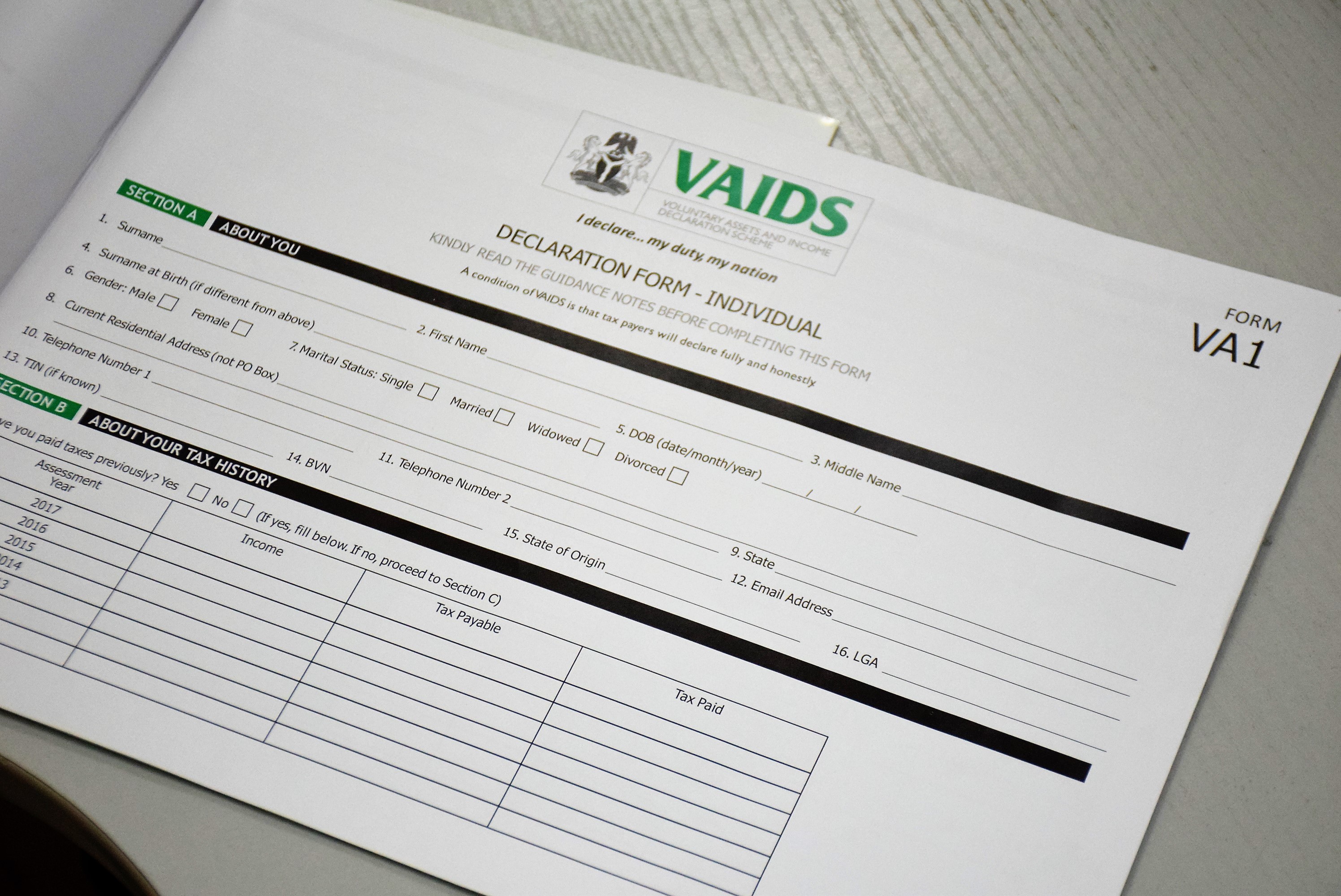Recently, the Federal Government of Nigeria introduced the voluntary assets and income declaration scheme (VAIDS), encouraging Nigerians to declare their tax liabilities in exchange for amnesty. Most Nigerians have a perception of tax as part of several official legislations used by public officials to proverbially rob Peter to pay Paul. Moreover, they view taxation with cynicism, seeing that it has not aided any provision of public infrastructure.
The scheme was therefore envisaged to raise about US$ 1Billion by engaging members of the public in a manner that does not perpetuate the sense that their default in tax payment was lingering criminal case hanging over them like the proverbial sword of Damocles. While the scheme is welcome, certain parameters in tax collection management should be considered, especially the risk management aspect of tax administration and sustainability of collection administration and compliance mechanism beyond the timeframe of VAIDS.
Withholding tax (WHT), is an advance payment of tax targeting revenues of the receiving business or individual. The WHT draws from the identified revenue values in currency of the transaction ranging between 5 and 10 percent for a corporate entity and 5 percent for individuals. Tax administrators estimate a base of 30 percent of income after deducting allowable expenditure is permissible . The withheld sum is held without any accruable benefit to owner of credit for as long as it takes to use up credit generated by the withheld tax. The best practice in other tax territories is to have immediate remediation and refund of unused credit. This fund which is accrued to the Federation account is not put in any economic use for the clear benefit of funds in credit of the entity.
On the other hand, the value added tax (VAT) is an indirect tax on consumption of goods and services on both public and private entities and citizens. It is inclusive of the shelf price of any “vatable” goods and services. My concern here is VAT on public procurement, which I term “value reducing round tripping.” Risk has been defined by the ISO 31000(2009)/ISO guide 73, as the effect of uncertainty on objectives, including events (which may or may not happen due to lack of information) that may have negative impact on objectives. Accordingly, risk analysis is the process of highlighting the dangers to individuals, businesses and governments, posed by potential natural and human causes as well as adversities. In the case of taxation and tax administration in Nigeria, the focus has been on quantitative and compliance adherence which is used to evaluate and analyze risk.
Advertisement
Risks by nature are future issues that can be avoided or mitigated rather than present problems that must be immediately addressed. In that regard, the VAIDS program can be viewed through many prisms, though many have applauded the scheme. A deeper review will show that it may be a case of putting the cart before the horse. Another possible consequence is its effect on cash flow of companies and its impact on jobs and productivity. The economic implication of tied down funds in the case of withholding tax and the cost of collection of vat on public procurement which actually reduces funds for development is ignored. The policy document apparently does not have a tax perspective as it ignores the provisions of or the possibility of other means of tax settlement as provided by extant laws.
Tax administration in Nigeria over the last two decades of intensive reforms have focused on operational reforms through improved compliance and rendition of accurate returns to optimize tax collection. The focus of company income tax return is in the use of analytical tools to determine quantum of tax payable. Recently, integration of various financial transaction platforms has made more information available to tax administrators to collect optimum taxes. While this approach has increased tax yield, the burden has remained on already complying tax payers while ignoring the Raison d’être citizens don’t pay taxes. The aim of risk management is to help the tax administrators achieve their objective of optimum tax collection from tax payers; risk management being a technique that improves the tax administrator’s effectiveness in dealing with risk.
The tax administrator requires two critical items to effectively analyze risk. These are technical know-how and knowledge of the environment. Administrators have focused on the ‘technical’ and ignored the environmental risks posed by not mitigating the perception of internal management and utilization of collected resources. The concept of “government money” was conceived due to reliance on other sources of revenue such as oil money to fund government activities. This concept has manifested itself in how individuals deal with public property. Since the citizens do not pay taxes, they do not perceive that public resources are indeed public resources but government funds. Whereas, citizens who pay personal income taxes under the pay as you earn (PAYE) in their states of residence are discriminated against in the allocation of resources, in favor of indigenes who may never pay taxes – unless they work in formal institutions – further entrenching the “government money” mentality.
Advertisement
This is clearly shown when government property is destroyed where there is a disagreement with government officials. Proponents of coercive collection of taxes have argued that when the citizen is forced to pay taxes he will pay more attention to how such resources are utilized, while another school of thought argues that government must respect its social contract so that citizens will be happy to pay taxes. In that regard we may consider that risk management in taxation goes beyond technical and administrative solutions but a holistic approach, which takes cognizance of all variables and not an element.
The VAIDS scheme, while a good policy, is in my opinion a step too early, implemented to raise badly needed revenue and not the solution in tax administration. It is another collection strategy. We will see if a canon of taxation, economic cost of collection, will be achieved. In mitigating risk in tax administration, “revenue expenditure budget“ is imperative, rather than revenue collection budgets or targets as tax authorities call it. The concept of revenue budgeting is not alien, but Nigeria being a peculiar case requires that state and Federal tax authorities and the governments must tie revenue targets to specific projects which can be easily monitored by the citizens, unlike the national budget which is generally lacks citizens’ ownership therefore and subject to the executive choice of where to allocate budgeted funds.
We need to rethink the extant law provisions on “WHT” by innovative utilization of tax credits to boost finance available to the economy thereby increasing tax yield. In an economy where the private sector is in strong need for finance and sustainability, WHT tax credit presents a safe instrument for effective credit management which mitigates significant risk in credit management and presents alternative credit finance to the economy. Instead of government holding down funds, a percentage of tax credit available to companies can be utilized as collateral for burrowing. Its liquid in nature with the ability to recover credit by banks and other institutions through simple utilization of tax credits to offset failed loans, either to offset taxes due or cash in the credits with the government. This will free billions of naira to boost liquidity and feed the needs of financing in the economy.
It will also enhance compliance as companies can effectively utilize the funds within a financial year by offsetting their taxes and accessing credit with any excess.
Advertisement
The provisional tax act can be revisited to serve as the amount that is to be withheld from company revenues pending the determination of income and tax payable.
The deduction and remittance of VAT on public procurement in reality reduces funds available for development through the cost of collection and non-remittance. The process is to collect 5 percent vat on all “vatable” transactions by public institutions, which is shared in the next federation budget by the same entities who deducted the tax in the first place. The implication is that the administrative cost of collection by both remitting agencies and the Federal Inland Revenue Service (FIRS) when deducted, reduces the amount of funds available for public expenditure in every cycle, if you estimate the cost of collection by both remitting agencies and the FIRS at 6 percent of total funds available. All income earned and expended by Nigeria is reduced by 6 percent in every cycle of public expenditure. When you deduct the budgetary expenditure on health and education from total budget, you will have an idea of how much is lost to an unnecessary cycle.
Dikwa is a fellow, Chartered Taxation Institute and former inspector of taxes, FIRS.
Advertisement
t: +2348034515362
Advertisement
Views expressed by contributors are strictly personal and not of TheCable.
Add a comment







